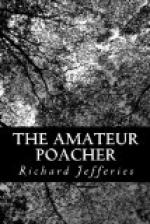The tall ash poles behind in the wood stand stark and straight, pointing upwards, and it is possible to see for some distance between them. No lesser bats flit to and fro outside the fence under the branches; no larger ones pass above the tops of the trees. There seems, indeed, a total absence of life. The pheasants are at roost in the warmer covers; and the woodpigeons are also perched—some in the detached oaks of the hedgerows, particularly those that are thickly grown with ivy about the upper branches. Up in the great beeches the rooks are still and silent; sometimes the boughs are encrusted with rime about their very claws.
Leaving the oak now and skirting the wood, after a while the meadows on the lower ground are reached; and here perhaps the slight scampering sound of a rabbit may be heard. But as they can see and hear you so far in the bright light and silence, they will most likely be gone before you can get near. They are restless—very restless; first because of the snow, and next because of the moonlight. The hares, unable to find anything on the hills or the level white plain above, have come down here and search along the sheltered hedgerows for leaf and blade. To-night the rabbits will run almost like the hares, to and fro, hither and thither.
In the thickest hawthorns the blackbirds and lesser feathered creatures are roosting, preferring the hedgerow to the more open wood. Some of the lesser birds have crept into the ivy around the elms, and which crowns the tops of the withy pollards. Wrens and sparrows have gone to the hayricks, roosting in little holes in the sides under the slightly projecting thatch. They have taken refuge too in the nest-holes made in the thatched eaves of the sheds: tits are there also; and sometimes two or three of the latter are captured at once in such holes.
A dark line across the lower meadows marks the course of the brook; it is dark because the snow falling on the water melted. Even now there is a narrow stream unfrozen; though the banks against which it chafes are hard, and will not take the impression of the moorhen’s foot. The water-rats that in summertime played and fed along the margin among the flags are rarely seen in winter. In walking in daylight by the brook now their plunge into the water will not be heard, nor can they be seen travelling at the bottom.
They lay up a store of food in a hole away from the stream, generally choosing the banks or higher ground in the withy-beds—places that are not often flooded. Their ordinary holes, which are half, and sometimes quite, under water, will not do for winter; they would be frozen in them, and perhaps their store of food would be spoiled; besides which the floods cause the stream to rise above its banks, and they could not exist under water for weeks together.




